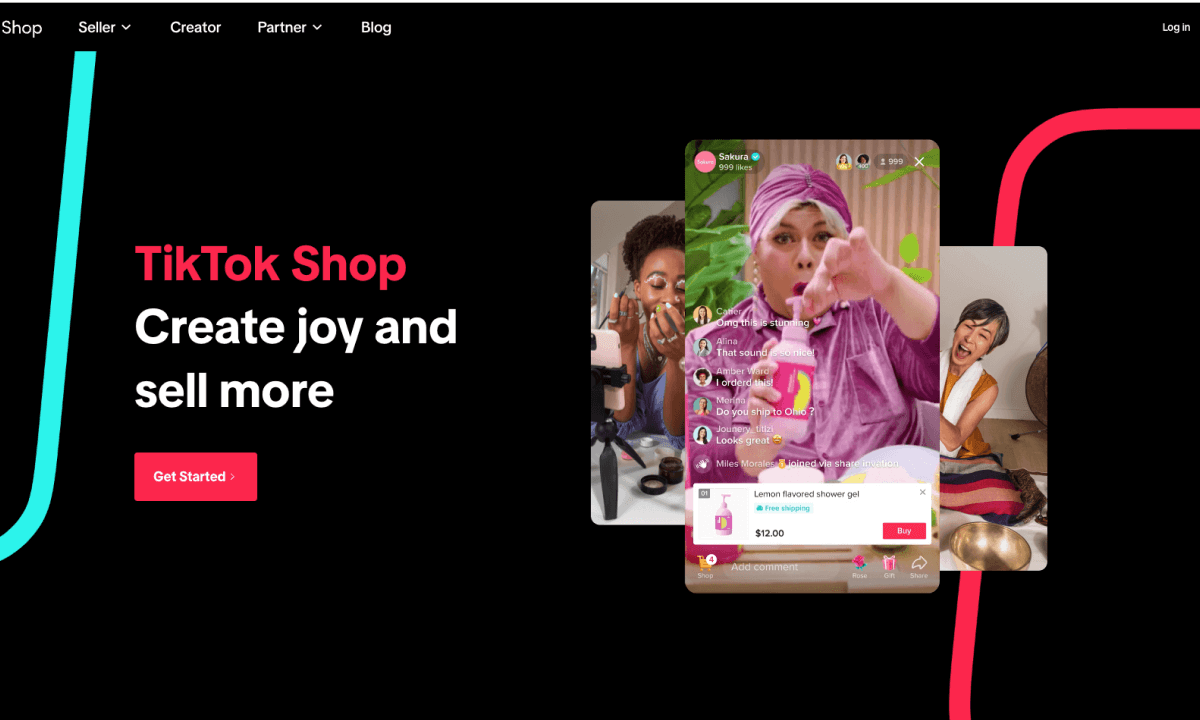Whether you’re just getting started with TikTok Shop (TTS) or looking to get more sales from the platform, read on to see how successful brands are leveraging the platform to skyrocket revenue. A lot of the examples below come from global brands, but we’ve included strategies with just as much potential for sellers of all sizes.
Note: At time of writing, TikTok Shop is only available in Indonesia, Malaysia, the Philippines, Singapore, Thailand, the United Kingdom, the United States, and Vietnam.
How to attract more customers on TikTok
1. Optimize your creative and targeting
Sure, you might strike it lucky and land an organic slot on the FYP (for you page), but ad spend is increasingly important if you want to hit your view and engagement goals, and ultimately increase the number of potential customers who see your content. Quality creative and targeting are the keys to success here.
Gymshark is a shining example of creative… well, creative. Their most popular post has 3.5M likes to-date. They’ve leaned heavily into a certain aesthetic—one that mirrors the gym-selfie-esque style their target market itself produces. They’ve just crafted an elevated version.
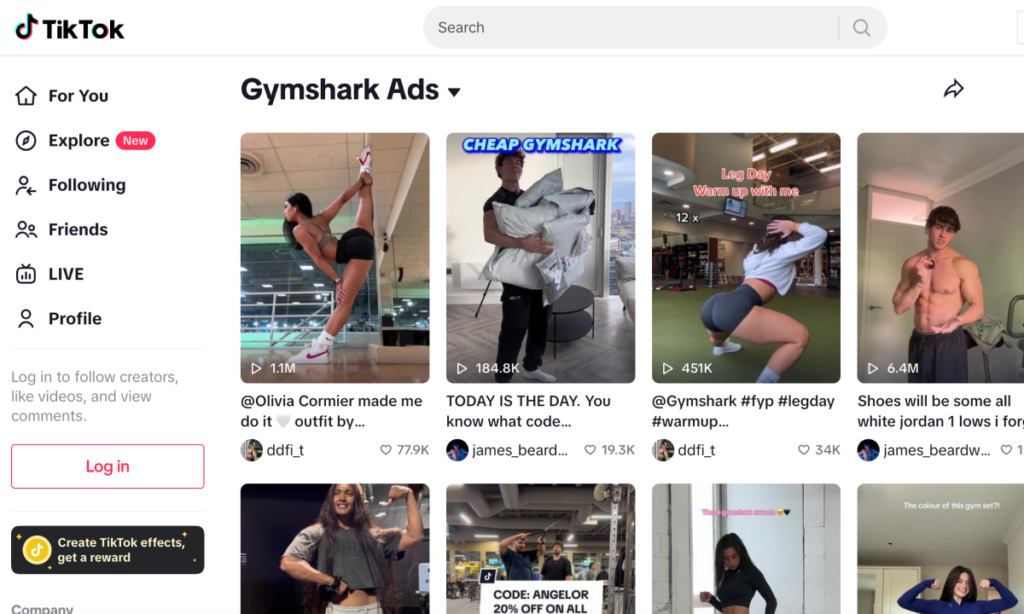
Their posts add an aspirational twist to the typical workout video, including gymnasts performing 540 degree bar spins, and dead hang challenges that make you sweat just watching them.
In terms of targeting, TikTok lets you refine your ad exposure based on demographics, interest and behavior, and device type.
It also gives you the option to use “Smart Targeting” which TikTok says, “expands your targeting settings when the system predicts it will be hard to deliver ads based on your initial targeting selections to reach a larger audience.”
You can also create custom audiences to get super specific. By optimizing for all the above, you can build up the number of people visiting your Shop. Given the $5.96B that brands and individuals spend on TikTok ads annually, the market obviously sees it as a worthwhile investment.
2. Collaborate with (good-fit) influencers
Social media has long been the refuge of influencers, micro and global alike. By collaborating with content creators who already have engaged followings, you can access an even wider audience.
Elevate your TikTok Shop success with seamless, scalable support:
Calvin Klein goes as far as making influencer marketing the core pillar of their branding, hosting notable celebrities like Cara Delevigne on their TikTok profile.
Don’t quite have the budget of a fashion conglomerate? Try partnering with relevant micro-influencers (those with 10K-100K followers) to help promote your TikTok Shop. These creators have an average engagement rate of 18% on TikTok, 14% higher than similar-sized influencers on Instagram.
Micro-influencers offer other benefits too. While larger influencers ask for significant payment per post, and often require a lot of negotiation with representatives and agencies, you can nurture much closer collaborations with micro-influencers. Instead of a one-and-done approach, it’s far more efficient to work directly with smaller influencers on multiple posts and complete campaigns.
Plus, by partnering with creators whose audiences are more niche, your business has a better chance of resonating with a targeted group that has significant interest in your brand’s unique selling points.
3. Ask your audience
Posting creatively and consistently is one of the biggest struggles TTS sellers face. To supplement the content your business can release solo, take your cue from Glossier and experiment with user-generated content (UGC).
The Glossier team regularly reposts tutorials and reviews featuring their products. By doing so, future customers get an unbiased take from people they can relate to. And, Glossier doesn’t have to so much as lift a finger to facilitate it.
Aside from encouraging reviews with free samples and promotions, there are plenty more ways to leverage your existing customers to get new ones. Hashtag challenges are a popular kind of UGC you’ll see right across TikTok, from Chipotle to Guess to BMW.
Converse is an all star—no pun intended—in this space too. So much so that they’re now the focus of a TikTok case study you can use for inspiration.
4. Learn a thing or two about SEO
SEO’s not just about getting found on Google. Any platform with built-in search functionality gives you the opportunity to optimize how often you show up in results, and how many potential customers you can reach as a result.
One experiment showed 3 factors that influence your content’s likelihood of showing up in the right feeds: using the right hashtags, using captions, and optimizing video descriptions.
In terms of hashtags, you can start by putting a short-tail keyword (a keyword that’s one to 2 words long) into TikTok’s hashtags tab and pulling the resulting list of the most popular related hashtags. Then, all you need to do is include them in your posts as relevant.
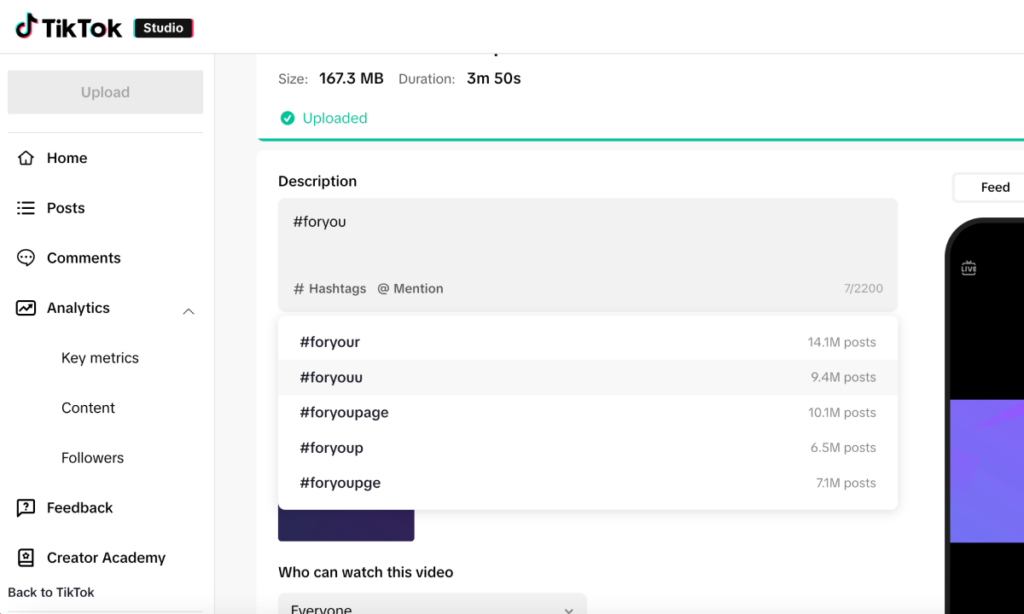
When it comes to captions, including them can give you a visibility boost as they give the TikTok algorithm context about your video that it couldn’t pull from audio alone. Just make sure to review any auto-generated captions as they can often make mistakes based on accents and pronunciation.
Finally, to optimize descriptions, the first thing is to include those relevant hashtags we flagged earlier. Then you’ll want to include copy that encourages viewers to interact including prompts and questions. This enhances your chances of engaging visitors and, in turn, the time they’re spending exposed to your products and brand.
5. Cross-promote on other socials
Repurposing your content on other social media platforms may seem repetitive or, worse, potentially boring for your target customers. However, between their different algorithms and audiences, you might be missing out on sales by relying solely on TikTok.
H&M have mastered this strategy. On Instagram, they integrate VR into their visuals. A smart move as it leverages the unique aesthetic of the metaverse on a channel owned by Meta themselves.
Conversely, for TikTok, they lean on moody, atmospheric styles. Their brand is recognizable in both iterations, but they leverage the different platforms’ users and their preferences to show different aspects and to convert on multiple fronts.
How to convert more customers on TikTok
1. Create engaging content
But what does “engaging” really mean? It’s largely subjective, but here are a few characteristics of content by major brands that stops folks scrolling past:
Follow (or start) trends
They started with pandemic-fuelled dance crazes, and TikTok’s trends aren’t going anywhere any time soon. By capitalizing on recurring themes TikTok users are into, you’ll naturally increase your relevance.
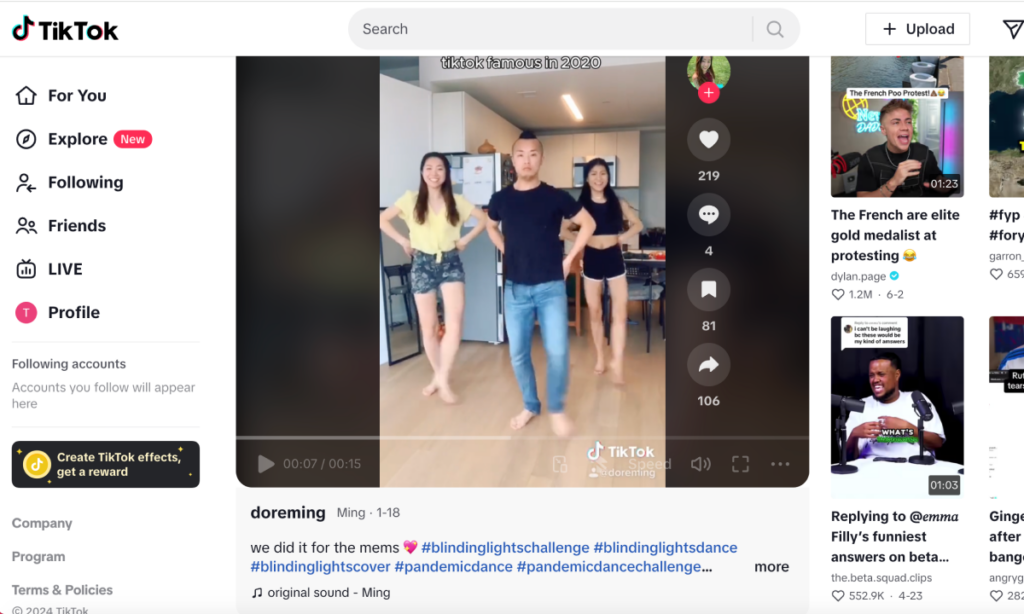
Ryanair (a popular European low-cost airline) jumped on the bandwagon of the “We’re X, of course we Y” template and saw 100K+ likes off the back of it.
Stay relatable
TikTok’s infamous for being a Gen Z staple. 44% of users are of that generation, after all. Even if you played with Tamagochis (or Tetris) instead of tablets as a kid, you can still capture the attention of this demographic.
Red Bull’s been around since 1984, and they manage it. They even publish articles sharing their knowledge of the Gen Z psyche. The takeaways from this that you can leverage to relate to this audience include making your posts bite-sized, socially conscious, funny, and even self-deprecating.
As a result of this commitment to understanding the needs of this generation, Red Bull’s a mainstay in the cultural zeitgeist, a claim that’s backed up by creators featuring their products time and again for the #aesthetic.
Add branded effects and hashtags
The video-first nature of TikTok offers unique opportunities for brands creating content for it. Not least, branded effects are a great way to pique the curiosity of first-time buyers.
Fenty Beauty, for example, lets TikTokkers do a virtual try-on of its foundation, all via a branded filter. That way, consumers can figure out which shade to buy—before they even visit the store—and Fenty gets extra views off the back of that convenience.
Keep it light
When the basic idea for social media came about, it’s not like its inventors had a grand vision for its role in eCommerce. While the 2 are inextricably linked now, sometimes your social commerce strategy can benefit by going back to basics.
Take Crocs. They leverage a dash of humor to keep customers coming in. For just one example, feast your eyes on their “Shronks”.
2. Run flash sales and exclusive promotions
A good old-fashioned percentage discount goes a long way to fuel the hype train on TikTok. ColourPop Cosmetics made the most of TikTok’s format by pairing their 30% off announcement with a mini unboxing of some of their bestsellers.
3. Make your products pop
Crumbl Cookie’s ads are as delicious as their product. High-quality food styling paired with a touch of FOMO for their next week’s menu serves up great inspiration for sellers. Too Faced also banks on visually luxurious ads to sell their products, including their plumping lip glosses.
Both brands stand out as users scroll because the vast majority of content on TikTok has a homemade vibe. Almost all the videos you come across might as well be signed off with “Filmed on my iPhone”.
While there’s nothing wrong with that format, adding extra production value to your ads has the potential to make them more eye-catching, helping you secure more visits and, ultimately, customers.
4. Understand your analytics
You’ll never know if ads are working if you don’t keep an eye on analytics. But, each social selling platform has unique ways of gauging performance.
For TikTok shop, you can see a breakdown of your sales indicators (GMV, items sold, buyers and average GMV per customer), traffic indicators (visitors, page views, view to click rate, click to paid rate), and in-depth indicators (average product clicks, page views divided by visitors and average visit time).
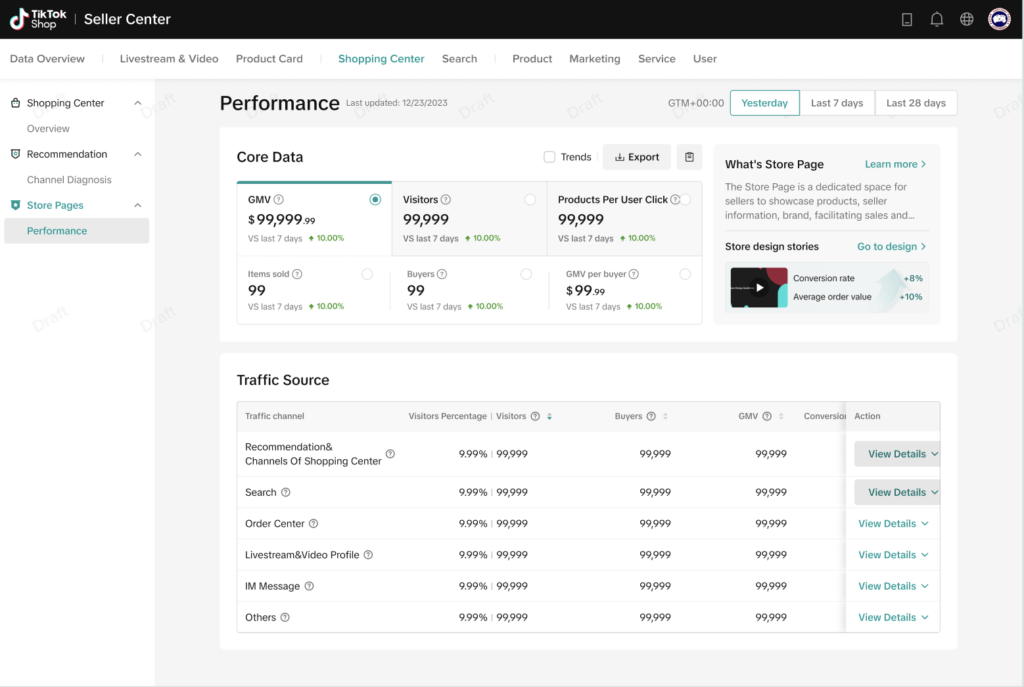
Image courtesy of TikTok.
By capitalizing on what’s working by these numbers—and ditching what’s not—you can continue to iterate on your strategy and scale your success on TikTok Shop.
How to keep more customers coming back on TikTok
Acquiring a new customer costs approximately 5 times more than retaining an existing one. While the strategies we’ve touched on so far all increase your chances of bringing new buyers in, it’s important to keep them coming back once you’ve sealed the deal. With that in mind, here are some evergreen strategies for retention.
1. Optimize your customer service
This is a big one. By adopting automation strategies, sellers using centralized customer support platforms like eDesk have reported a 4x uptick in productivity.
Once you start getting a high volume of sales from TikTok Shop, you’re inevitably going to get a higher volume of support requests. As your resources get stretched thinner on that front, it’s important to make sure your support quality doesn’t decline as a result.
One way to safeguard against that is to make your processes and systems for customer support as seamless as possible.

2. Follow TTS policies to the tee
Late last year, TikTok blocked 37 million product listings. That only represents a small percentage of the total number of listings at any one time on TTS, but it’s worth avoiding your posts being taken down or, worse yet, a full on ban.
We’ve got a detailed breakdown of all of TikTok Shop’s seller policies right here so you can stay informed and stay selling within their guidelines.
3. Engage with your audience, always
Visibility helps you stay top of mind, of course, but just because TikTok users can see your Shop, it doesn’t mean they necessarily know enough about your products to make a purchase.
Take an active role in your customer relationships to help move things along. Respond to any comments that come in, and interact with other brands’ and users’ posts with similar interests. Just make sure to avoid direct competitors.
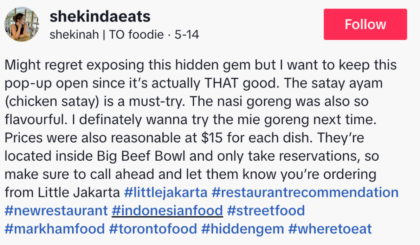
If your audience isn’t naturally engaging on your posts, a live stream might be a good option to up the ante. Most followers will get notified when you go live on TikTok, meaning you can grab a lot of attention in a short space of time and build up more brand awareness off the back of it.
4. Encourage reviews and testimonials
Caveat emptor’s never been more relevant. With the democratization of eCommerce, the barrier to entry for anyone to sell online is extremely low. Manipulating this fact, some bad actors have, let’s just say, duped customers with less than ideal merchandise.
Buyers are adapting and exhibiting more caution, but they’ve become somewhat more skeptical of online stores they’re not familiar with as a result. Reviews and testimonials are the not-so-secret weapons you can use to combat this. Once you can prove your products’ quality, you up your odds of selling.
You can leverage feedback software to create a well oiled process to celebrate your happiest customers and resolve the concerns of those that are less satisfied.
How to get more TikTok Shop sales—the TL;DR
Depending on how long you’ve been selling on TikTok Shop, invest your time accordingly between promotion, conversion and retention strategies.
The common theme to focus on in each of those efforts is to do all in your power to foster happy customers by understanding them, relating to them and doing everything you can to improve their experience.
→ Elevate your TikTok Shop success with
seamless, scalable support!
